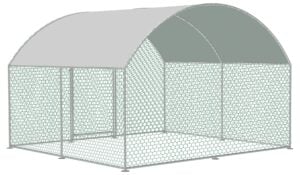Red mites could well be one of the biggest problems you will face as a chicken keeper, therefore it’s important you have all the information you need to ensure you can effectively treat and prevent red mite in your chicken house.
Red mites are blood feeling parasites that live in the cracks in your chicken house and feed on birds during the night. They will normally only pose a serious problem during the summer months, nonetheless, it’s something you should be aware of throughout the year. The mites can’t fly and instead crawl along perches to get to your chickens. Red mites will feed off all parts of the bird including their blood, skin and feathers.
A major infestation can create a very serious problem, red mites can damage your chickens’ health, making them anaemic, causing extreme skin irritation, affecting egg production and in very severe cases, causing deaths amongst your flock.
The Life Cycle of Red Mite
As mentioned above, red mites live in the cracks and crevices of your chicken house as this is an ideal place for them to lay their eggs or mite larvae. Hatching after 2-3 days, it only takes 7 days for the mite to develop from the egg stage to adulthood. With such a short cycle it’s not hard to see why infestations can evolve so rapidly, this is why it’s so important to remain vigilant, particularly during the summer months. Red mites are a very hardy pest and can survive without a food source for up to 8 months.
Checking for Red Mite
Undoubtedly, red mite infestations can have drastic consequences, however there are several warning signs you can look out for, enabling you to prevent a full blown infestation occurring.
If you haven’t come into contact with them before, red mites can be difficult to spot if you’re not sure what you’re looking for. Once you know what to expect, looking for signs of them during your cleaning routine will be much easier.
As red mites feed at night, they are particularly difficult to spot during the daytime; therefore the best time to check for signs is at night or early in the morning. One of the most effective ways to check for red mites is to simply wipe the underside of the perches with a tissue to pick up any signs of blood. After feeding, red mites look like clumps of blood which just look like spots of blood when squashed.
A major tell-tale sign you have a red mite problem is if you’re chickens are reluctant to enter their house at night.
Other Signs of Red Mite:
- A build-up of grey dust (mite excretion) in the hen house, particularly under perches and timber joints.
- Grey and red mites of around 0.7mm in size. The mites change colour depending on their digestive cycle – before feeding, mites will be almost white in colour.
- After feeding they will be a deep shade of blood red, slowly turning to a grey / black colour as they digest the blood.
- Spots of blood on eggs
- A drop in egg production or hens stop laying all together
Symptoms you may notice in your chickens include:
- Anaemia and even death in chickens that are young or those who were particularly weak to begin with
- Instead of their normal red colour, combs and wattles may appear paler
- Restlessness in your flock
- Lethargy in chickens
Eradicating Red Mite Infestations
If you have spotted a serious red mite infestation, there are several products you can use that are non-toxic and 100% natural.
Poultry Shield
This is probably the most popular product for the eradication of red mites. It comes in liquid form and acts as a multi-purpose cleaner and sanitiser. Not only is it very effective in removing red mite it’s also great to use during regular cleaning of your coop.
Poultry Shield works by breaking down the organic matter and wiping out the red mite’s habitat. The product also works to remove the waxy coating on the mites themselves, causing the parasites to dehydrate and die. It’s available both as a concentrated liquid and a ready to use spray. If you choose the concentrated option, application via a pressure washer is ideal.
Diatom Powder
Diatom powder can be used in conjunction with Poultry Shield, creating a two pronged approach that is highly effective when treating red mite infestations. This product is a dusting powder that can be sprinkled throughout the chicken house, focussing on perches as well as cracks where mites may hide. When scattered amongst bedding it can drastically reduce red mite numbers, working in a similar way to Poultry Shield it removes the wax outers on the mites, killing them within a very short period of time. Diatom powder is a type of algae; it’s a completely natural product and can therefore be applied directly to the bird if necessary.
Preventing and Controlling Red Mite
Completely getting rid of red mites is very hard, often the best course of action is to drastically reduce the number of red mites and then find an effective preventive method that works for you.
After the initial eradication treatment, there are a number of long terms options you can choose to control red mite. Many chicken keepers adopt an organic approach in all aspects of flock management so please be aware that some of the methods listed below rely on the use of chemicals.
- Steamers that would normally be used to strip wallpapers from walls can be used in your chicken house, providing an effective way to clean out those cracks and crevices were red mites live
- Painting paraffin into cracks, or applying a mix of paraffin and Vaseline into crevices
- Sticky flay papers can be stuck to the underside of perches to trap mites
- Coke drinks can be poured into cracks and anywhere mites may be hiding, working in a similar way to Poultry Shield, the coke dries out the waxy exterior of the mite, dehydrating and killing them
Red mite is an incredibly common problem that almost all chicken keepers will have to deal with at some point. However, providing you’re vigilant in your actions, carry out preventative methods and treat any serious infestations quickly and efficiently, your chickens will be happy and healthy.




